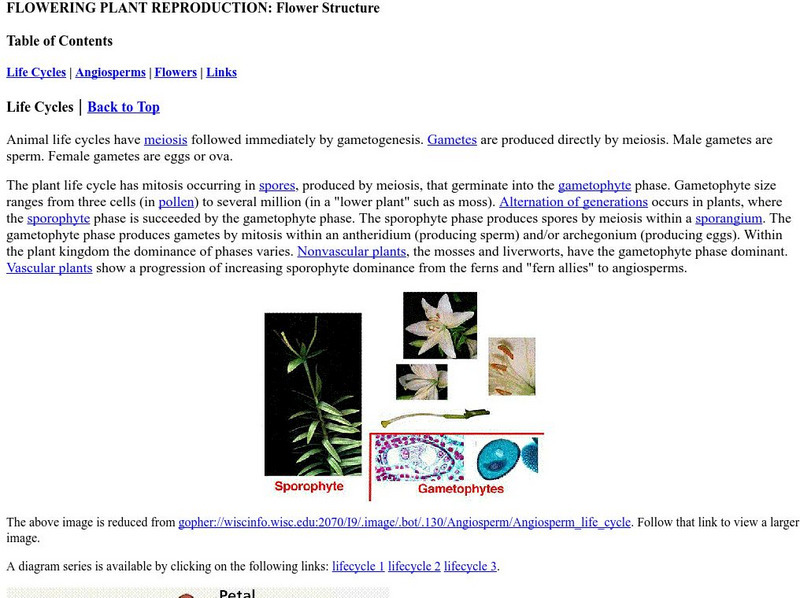Curated OER
Cell, Socks, and Sex
Donate old socks for science! Young biologists model mitosis and meiosis, using socks as chromosomes and a balloon as a nucleus. This ingenious idea for modeling cell division will be more memorable to your young biologists than any set...
Curated OER
Meiosis Worksheet
These two pages cover the gamut of topics regarding reproduction and DNA replication. Structures, processes, functions, and reasons for them are tested here. The questions are mostly multiple choice, but there are also a few...
Curated OER
Organizing Principles of Plants and Animals
Three lessons and five assessments are contained in this material. Various paper shapes are sorted as a simulation of biological classification. Learners gather a list of living things that they are familiar with and design a...
Curated OER
Mitosis and Meiosis Exercise
In this cell division activity, students answer 13 multiple choice questions based on the process of mitosis and meiosis. Included are questions about the stages of cell division as well as the structures involved.
Curated OER
Meiosis
In this meiosis learning exercise, student complete the blanks describing the process of meiosis. Students draw a diagram of homologous chromosomes.
Curated OER
Sexual Reproduction and Meiosis
In this biology worksheet, 9th graders label each of the diagrams representing the stages of meiosis. Then they describe how gametes vary from other cells in the body. Students also explain what happens during the process of fertilization.
Curated OER
Hardy-Weinberg Equilibrium According to Hoyle: OR, Population Genetics or Platypapyrus foursuitii
Students use this exercise to help achieve a working knowledge of the Hardy-Weinberg Equilibrium without recourse to algebra. After participating in this activity, students gain a feeling for the significance of the Hardy-Weinberg...
Curated OER
Genetic Terms
In this biology worksheet, students identify and locate various vocabulary terms related to genetics. There are 15 biology terms located in the word search.
University of California
Ucmp: Introduction to the Fungi
A wonderful place to learn all about the fungi. click on the buttons at the bottom of the page to go to sections on their life history, systematics and morphology.
San Diego State University
Sdsu: Lesson 2.5: How Do Organisms Reproduce? Meiosis
This site will allow students to grasp the complex concept of meiosis by modeling the process with clay.
Khan Academy
Khan Academy: Chromosomes
This informative resource features an overview of genetic material: DNA, chromosomes, genomes, homologous chromosomes, sister chromatids, and haploid/diploid.
Cornell University
Cornell University: Cell Division: Genetic Consequences
Review, identify, and describe the important steps in the cell reproduction of whitefish, onion root, and lily anther, and quiz yourself on the similarities and differences between mitosis and meiosis. A "Cell Division Construction Kit"...
Estrella Mountain Community College
Estrella Mountain Community College: Flower Structure
Site covers all aspects of plant reproduction such as life cycles, angiosperms and flowers. Provides links to other sites to aide in research.
CK-12 Foundation
Ck 12: Biology: Meiosis
[Free Registration/Login may be required to access all resource tools.] Describes the phases of meiosis.
CK-12 Foundation
Ck 12: Life Science: Meiosis
[Free Registration/Login may be required to access all resource tools.] Sexual reproduction combines gametes from two parents. Gametes are produced by a special type of cell division known as meiosis. Meiosis contains two rounds of cell...
PBS
How Cells Divide: Mitosis vs. Meiosis
This site provides both illustrations and text to compare and contrast the stages of mitosis with meiosis.
Wikimedia
Wikipedia: Meiosis
This site from Wikipedia the encyclopedia is a concise site that is technical in nature but links are provided for clarification. Includes a comparison between meiosis and mitosis.
Other
Principia Cybernetica Project: Insect Societies
A description of the evolution of the caste differentiation in insect colonies.




















